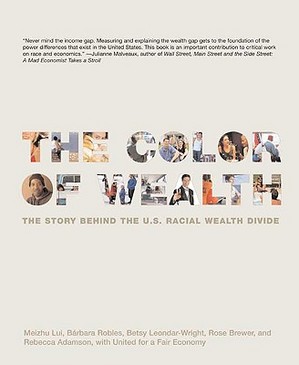The color of wealth: the story behind the U.S. racial wealth divide
"For every dollar owned by the average white family in the United States, the average family of color has less than one dime. Why do people of color have so little wealth?"

Join Interfaith Council for Peace and Justice for a discussion of The Color of Wealth on Oct. 28 and Nov. 30, 7:00 p.m., 1679 Broadway, Ann Arbor.
The Color of Wealth thoroughly explores the dynamics that limit wealth creation for Native Americans, Blacks, Latinos and Asians and the arrangements that benefit whites, describing how “for centuries [people of color] were barred by law, by discrimination, and by violence from participating in government wealth-building programs that benefitted white Americans.”
The authors take a long historical look from the founding of the country to the present day, recognizing that “income can change on a dime, but wealth changes over generations.”
It is precisely this generational impact that wealth, or lack of wealth, has that makes it so important. For example, when I was buying a house, my parents helped me with the down payment. It doesn’t take anything away from my hard work in school and my job to acknowledge the help they gave me or to recognize that not every parent can give the same assistance my parents gave me.
Likewise, The Color of Wealth points out that, just as my parents were able to help me build wealth, throughout America’s history there have been policies and practices that have helped white families like mine build wealth.
To illustrate, the authors out that in the 1950s, a large number of white male veterans went to college on the GI Bill, and many white families became homeowners as the federal government subsidized roads, infrastructure, and mortgages in the suburbs.
African American veterans, however, found that the GI Bill only offered them educational benefits at historically black colleges with too few spots for the number of applicants, and the new suburbs almost universally excluded non-white home buyers.
The authors also show how policies that exacerbate the racial wealth gap continue today. Sometimes these policies are blatant, such as the 1980s class action lawsuit in which the Equal Employment Opportunity Commission ruled that the Department of Agriculture gave white famers more help, quicker help, and on easier terms than black farmers.
Other policies are more subtle, such as how the practice of rating credit worthiness by how well people have paid back debt leaves out people who have never incurred debt and pay in cash, which is a common practice among Vietnamese families.
The Color of Wealth is extensive in cataloging the policies and practices that have brought us to the large racial wealth gap. The centuries of discrimination and myriad policies that perpetuate inequality can be a bit overwhelming.
Thankfully, the book closes with a chapter on “Rainbow Economics” that surveys some of the solutions to the divide. Their proposals include addressing racial disparities in school funding and healthcare, providing a living wage, and creating rotating savings and credit associations that can help families start a small business or send a child to college.
As Americans, we tell ourselves that this is a country where anyone can get ahead. The Color of Wealth does a great job describing the ways we do not have a level playing field when it comes to wealth accumulation, and the ways we can make the field more level.
You are welcome to explore these themes as part of the Racial Justice Book Group hosted by the Interfaith Council for Peace and Justice. We will be discussing chapter one of The Color of Wealth on Oct. 28, and chapter two on Nov. 30. The book group meets at 7 p.m. at Northside Presbyterian Church/St. Aidan’s Episcopal Church, 1679 Broadway, Ann Arbor (at the corner of Baits and Broadway, map). For details email info@icpj.net or call 734-6639-1870.
The Color of Wealth is available for special order through Nicola’s Books.

